Frankly, I would have preferred to compare the Yuneec Typhoon H with the Phantom 4, but life isn’t that generous; I own “only” this Yuneec Q500 4K and DJI Phantom 3 Advanced (for the moment >:)). Lately, I found many quadcopter reviews and comparisons made by ones that didn’t even see in reality the product. In my opinion, it is fairer to truly review an older product than just putting together some speculations in a kind of a review about a new and trendy product.
DJI and Yuneec Electric Aviation are currently probably the biggest players in the consumer drone market so the battle between them is quite fierce.
I just realized that this will be my first article of this kind as I have not yet compared two quadcopters side-by-side. The idea came when I observed how many drone enthusiasts are oscillating between these two quads and I thought a comparison review might help them in making this decision.
Both Yuneec Q500 4k and DJI Phantom 3 are amazing quadcopters in their own way. These two have not just completely different designs but also different features. Promise that I will honestly underline all the pros and cons of these two competitors.
Yuneec Typhoon Q500 4k vs DJI Phantom 3 Advanced
Firstly I received for review the Yuneec Q500 4k, which was my first truly impressive quadcopter. About two months later, I got the Phantom 3 Advanced.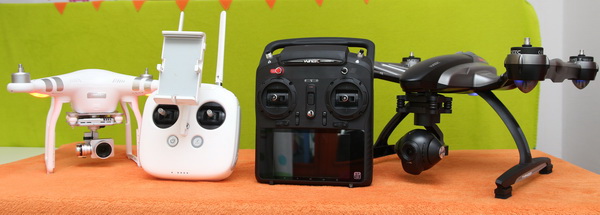
On first impression, the biggest advantage of the P3A over the Yuneec 4k was the much greater flight and FPV range. While everywhere (RC Forums, Facebook, and Reddit) I have read that the image quality of the DJI Phantom 3 is better, after testing both of them, I found out that the Yuneec’s 3-axis gimbal offers much smoother videos with less jello effect.
Both quads come in RTF (ready to fly), which mostly means there’s no assembly required; just charge the batteries and fly.
Contrary to the DJI Phantom 3 package, where after a few flights you will find that you need to additionally purchase some accessories, the Yunnec’s package is very rich.
I already purchased for my P3A a second spare battery, 64GB memory card, 7″ tablet, and I still need to buy a sunshade, lens filters and car charger.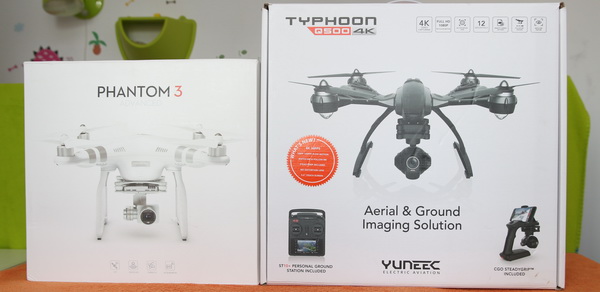
The Yunnec comes basically with all the accessories that you might need. I appreciate very much the fact that the transmitter has an integrated FPV screen and also a second-flight battery (which allows in total about 40-50 minutes of flight time). The StadyGrip is also a nice feature that allows using the 4K camera on the ground without paying $500 for an expensive gadget like the DJI Osmo.
You can find the detailed description of the included accessories in my reviews for these two quadcopters. Thanks again to HobbyWOW and B&H Photo, who offered me these two quadcopters, making this side-by-side comparison possible.
Yuneec Q500 4k vs DJI Phantom 3 – Design and build quality
Regarding the build quality, I can say that both drones are well-built with self-tightening propellers and wire-free batteries.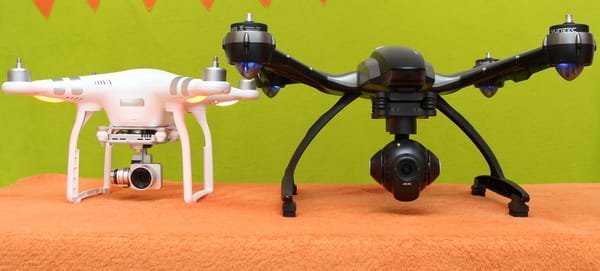
Both models have a nice design in their own way. I loved the professional and aggressive look of the Yuneec 4K while my wife appreciates the clean, elegant lines of the DJI Phantom 3.
As you can see in the photo above, the Yuneec Q500 is slightly bigger than the DJI P3, which somehow has a negative impact on the flight characteristics.
While the DJI Phantom’s lifting power is generated by four “standard” KV800 brushless motors, the Yuneec Q500 4k is equipped with unusually large KV700 motors.
During take-off and landing, I found the design of the Yuneec’s landing gears more stable. I managed to safely land on windy days without flipping over as it happened with the P3A. I read that many prefer the hand-catching way to finish the flight, but after I saw the injuries that can be produced by the propellers I never had the courage to test it.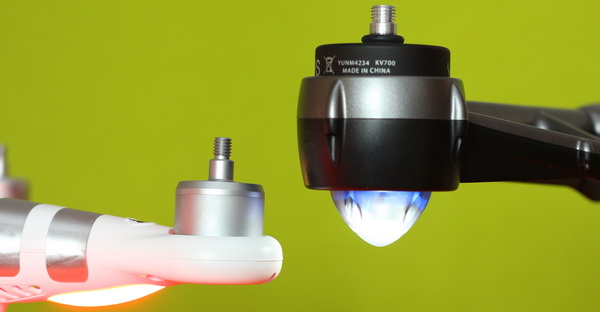
While the Yuneec has a dedicated On/Off switch, the DJI Phantom 3 can be powered ON through the smart battery’s button. The P3’s battery features a charging level indicator, which is great, so you can easily check if you’re spare ones are empty or charged ready to fly.
Yuneec Q500 4k versus DJI Phantom 3 – Transmitter
The biggest visible difference between these two transmitters is the FPV screen. While the Typhoon 4K transmitter features a 5.5″ touchscreen, the P3A transmitter has only a universal tablet/smartphone mount.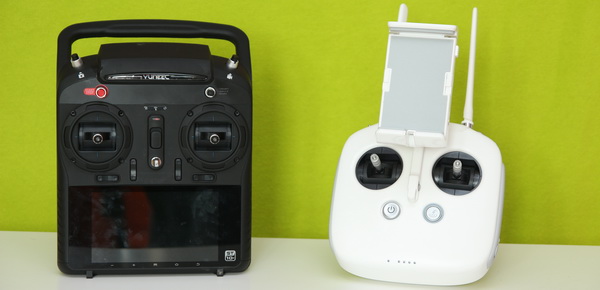
The Phantom 3′ transmitter is powered by a built-in 6000 mAh battery, and the competitor’s remote controller has a removable 5200 mAh battery.
According to the operator’s preferences, both remote controllers can be switched easily between mode 1 and mode 2.
In the case of Yuneec’s transmitter, I found it very convenient to have all the info (flight parameters, setting menus, and live video feed) in my hand without any additional device. Although the FPV display of the ST-10+ is pretty bright, you will need to mount the included sunshade during sunny days. In my opinion, the motor arm/disarm button is very useful and should be adopted by other manufacturers too. The quadcopter will follow the transmitter when the “Follow-me” mode is enabled, thanks to the RC’s built-in GPS positioning system.
On the other hand, the DJI transmitter features the revolutionary Lightbridge HD video down-link which allows transmitting high-quality 720P@30 fps live video up to 3 km. Almost any Android or iOS mobile device (tablet/smartphone) can be connected through the included micro USB cable to the transmitter in order to display the real-time video feed and access the quadcopter’s settings.
Certainly, DJI wins in terms of control range over Yunnec, allowing about 5 times higher distance flights. Anyway, in most countries, it is illegal to fly over the sight of view.
Yuneec Q500 4k vs DJI Phantom 3: Camera and gimbal
Probably the most important factor for many people when they consider buying a quadcopter is the quality of the camera. Both cameras are installed under the belly of the aircraft through a 3-axis gimbal which automatically corrects any slight movement of the quadcopter.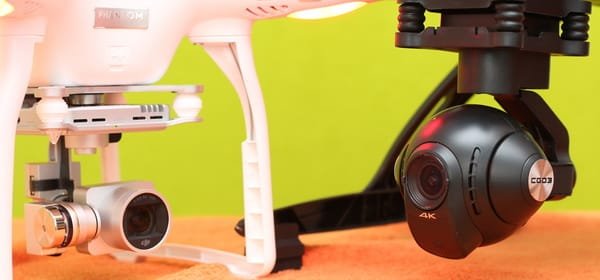
The only difference between the Phantom 3 Advanced and the Phantom 3 Professional is the camera. While the Professional edition features an Ultra HD 4K camera, just like the Yuneec Q500 4K, the Advanced has an “only” 2.7K camera.
Speaking for myself, the resolution is not everything. I prefer to capture videos with 1080P at 60fps more than 4K/2.7k at 30 fps. For those who intend to create some cool slow-motion videos, the Yuneec CG03 camera allows to capture Full HD videos with up to 120 fps.
To obtain the best field of view, both models allow to remotely tilt the camera up or down. To pan just turn the quadcopter around its axis.
While both cameras feature 1/2.3″ image sensors, the Yuneec’s CGO3 has a slightly wider lens (115°) compared to the 94° of the DJI Phantom 3 series.
Thanks to the included CGO SteadyGrip, the Yuneec’s camera goes beyond aerial filming, allowing to use the camera on the ground just like the DJI Osmo.
If you ask me about which camera is the winner, I would say that Phantom 3 Advanced offers better video quality. The captured aerial videos are crisper and have a better dynamic range. In contrast, the Yuneec’s gimbal seems to do a better job allowing to capture smoother videos even on windy conditions.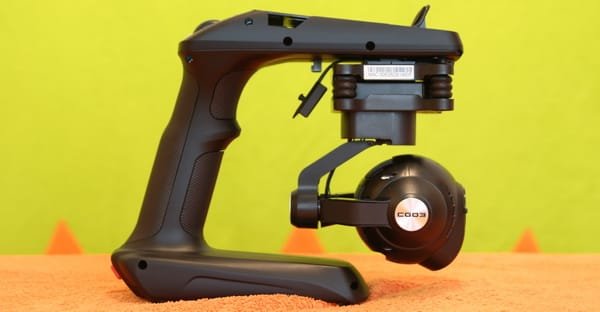
Thanks to the DJI GO App you can share the Phantom’s live video feed in real-time with your friends through YouTube and Facebook.
Regarding the storage of the photos and videos, both cameras accept micro SD memory cards. While DJI includes, together with the Phantom 3 a 16 GB card, Yunnec includes a four times bigger 64GB memory card.
BTW, it is good to know that both cameras allow for recovering unfinished videos due to powering OFF before you stop the recording.
Yuneec Q500 4k vs DJI Phantom 3: Flight characteristics
Both models can be easily controlled, even by new pilots. I prefer the more friendly one key motor arm/disarm function of the Yuneec over the DJI’s control stick combination. Both quadcopters can take-off and land manually or autonomously.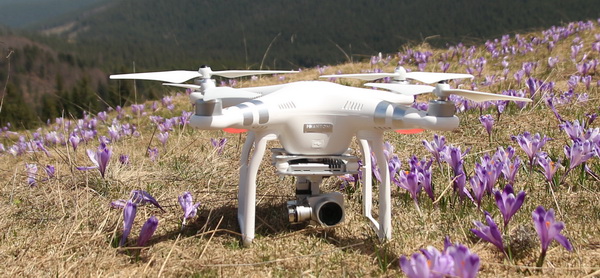
As I previously mentioned, due to its large size, the Yuneec is less fast and agile than the DJI Phantom 3. This is not a big disadvantage because you probably won’t race with this Yuneec, and for aerial filming, the gentle acceleration is just perfect. The resulting videos are very smooth and steady.
Contrary to my expectations, being bigger and heavier, Yuneec has better flight autonomy. It allows for about 2-minute longer flights over the DJI Phantom 3.
Certainly, for those who are interested in long-distance flights, the Phantom 3 is their model. It has a much longer control range than the Yuneec.
Pairing a 10″ tablet with the DJI Phantom 3 offers a much more enjoyable real-time video transmission compared to the Typhoon Q500 4k has.
DJI claims that their innovative “Vision positioning” system featured by the Phantom 3 Advanced and Professional allows safe flying even indoors. Frankly, I didn’t dare to fly in large indoor spaces (such as churches or sports halls) in order to test this feature yet, especially because I would never like to take the risk of crashing over people.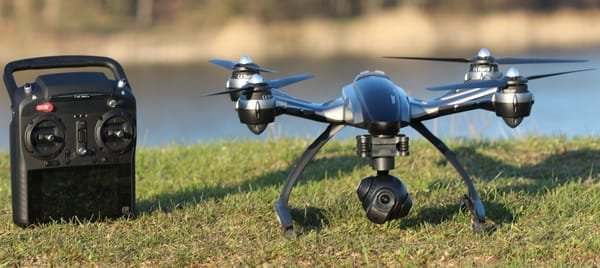
Yuneec Q500 4k and DJI Phantom 3 in-depth comparison table
| Yuneec Q500 4K | DJI Phantom 3 Advanced | |
| Package content | 2 flight batteries, transmitter, 2 sets of props, SteadyGrip, lens filters, car charger, sunshade and 64GB micro SD | Flight battery, transmitter 2 sets of props, tablet/phone holder, 2 sets of props and 16GB micro SD |
| Design | Imposing a professional look | Clean, elegant lines |
| Dedicated motor Arm/Disarm button | Yes | No |
| Control Range | Up to 600 meters | Up to 3.5 Km |
| Maximum flight speed | 35 kph | 57 kph |
| Flight time | 25 minutes | 23 minutes |
| Collision avoidance | No | No |
| Vision positioning | No | Yes |
| Camera | video: 4K, photo: 12MP | video: 2.7K, photo: 12 MP |
| Raw photo | Yes | Yes |
| Audio recording | Yes | No |
| FPV display | Yes | No |
| HD down-link | NO | Yes |
| Flight battery | 3s 5400 mAh | 4s 4480 mAh |
| Mobile APP | CGO | DJI GO |
| Others | SteadyGrip | HDMI output module for FPV |
| Price | $896 | $799 |
| More details | Yuneec Q500 4K review | DJI Phantom 3 Advanced review |
* red means better
Probably the above comparison table could have more rows, but I tried to underline only the most important characteristics of these two quadcopters.
Conclusions
On one hand, we have a professional-looking quadcopter with many included accessories, and on the other hand, a more versatile quadcopter with better control and FPV range.
Definitely, DJI offers more awesome features through the DJI GO APP than Yuneec with its CGO APP. Unfortunately, in order to truly enjoy all the capabilities of the DJI Phantom 3 you will need to spend a few extra bucks for the second flight battery, bigger memory card, tablet, and sunshade.
On the contrary, by offering for free their SteadyGrip, Yuneec will save you a few bucks from purchasing a handheld 3-axis gimbal for your action camera (of course, in case you need one).
So the decision is up to you, whether you are interested in higher value or more features and better flight performances.

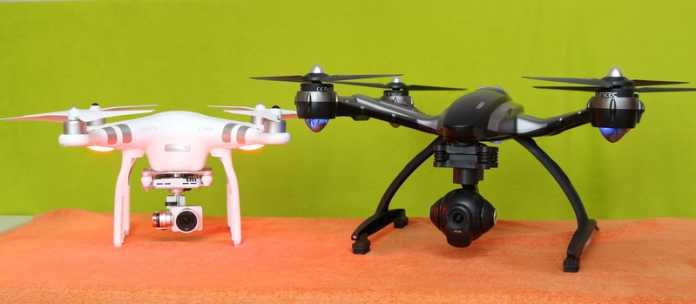
Great comparison! I’ve been considering both drones for aerial photography, and your insights on their features and performance really helped clarify my decision. The 4K video quality of the Yuneec Q500 is impressive, but the reliability of DJI is hard to ignore. Thanks for breaking it down!
These drones are not “Flying” Drones. There are other, better drones for that. These are camera mounts. The Phantom series are way ahead of the competition. Although a little more expensive, you get what you pay for. The new DJI Cameras are unbelievable. And that is what you buy a camera drone for.
Hello,
I am very undecided between these 2 drones and the difference in size is really what makes me lean toward the DJI at the moment.
The Yuneec seems super rich in features but very very bulky. However having to use a phone or tablet is kind of a annoyance to me (by the way I do not own a drone and never have).
Can the Yuneec drone fly without the camera on if there is no need to record videos, say just for the sake of flying? Seems that on the DJI the camera just cannot be removed.
thx for your time
The Yuneec’s camera is easily removable and can be also used as handheld camera.
I didn’t tried to fly it without camera but in my opinion it should be just fine.
Thank you!
this was very helpful! I will opt for the P3 Professional because i need the 4K resolution.